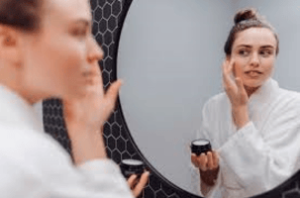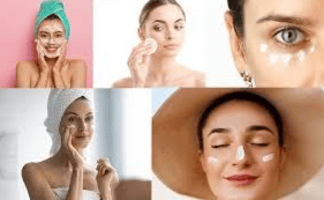Navigating the world of skincare can feel like solving a complex puzzle. The sequence in which you apply your products significantly impacts their effectiveness—applying them incorrectly can diminish their benefits or even cause irritation.
This comprehensive guide will walk you through the ideal order for both morning and evening skincare routines, helping you maximize the benefits of every product in your collection.

Why Is Your Skincare Routine Order Important?
Before diving into the specifics of what order should my skincare routine follow, it’s important to understand why sequence matters in the first place. Skincare products have different molecular sizes, pH levels, and active ingredients that work best when applied in a particular order. Generally, products should be applied from thinnest to thickest consistency, which helps with absorption and effectiveness.
Applying products in the wrong order can create barriers that prevent beneficial ingredients from penetrating the skin. For example, applying a thick moisturizer before a lightweight serum would prevent the serum’s active ingredients from reaching deeper layers of your skin where they’re needed most.
Morning Skincare Routine: Step-by-Step Guide
Your morning routine should focus on protection and prevention, preparing your skin to face environmental stressors throughout the day. Here’s what order should your skincare routine follow in the morning:
Step 1: Cleanser
Start with a gentle cleanser that removes overnight buildup without stripping your skin’s natural oils. Morning cleansing should be lighter than evening cleansing since your skin isn’t typically dealing with makeup or significant pollution buildup from overnight.
- For oily skin: Consider a foaming cleanser with ingredients like salicylic acid or tea tree oil
- For dry skin: Opt for a cream-based or hydrating cleanser with ingredients like glycerin or hyaluronic acid
- For sensitive skin: Choose a fragrance-free, soap-free cleanser with calming ingredients like chamomile or aloe vera
Step 2: Toner (Optional)
Apply toner with clean hands or a cotton pad to balance your skin’s pH and prepare it for subsequent products. Modern toners are formulated to hydrate and soothe rather than strip the skin.
- Glycerin and hyaluronic acid are ingredients in hydrating toners.
- Exfoliating toners may contain gentle AHAs (alpha hydroxy acids) or BHAs (beta hydroxy acids)
- Look for toners free from alcohol if you have dry or sensitive skin
Step 3: Treatments/Serums
Apply targeted treatments and serums while your skin is still slightly damp from toner. This is where you address specific skin concerns through concentrated active ingredients.
- Vitamin C serums work well in morning routines for antioxidant protection
- Hyaluronic acid serums help maintain hydration throughout the day
- Niacinamide serums can help with oil control and minimizing the appearance of pores
When considering what order should my skincare routine follow, always remember that water-based serums should come before oil-based ones.
Step 4: Eye Cream
Pat eye cream gently around the orbital bone using your ring finger, which naturally applies the least pressure. Your eyes’ surrounding skin is delicate and has to be treated with care.
- To reduce morning puffiness, go for eye creams with caffeine
- Peptide-rich formulations can help with fine line
- Brightening ingredients like vitamin C can help with dark circles
Step 5: Moisturizer
Apply moisturizer all over your face and neck to seal in hydration and create a protective barrier. Whatever your skin type, you must use a moisturizer.
- Gel moisturizers work well for oily skin types
- Cream formulations provide deeper hydration for dry skin
- If you frequently break out, look for labels that aren’t comedogenic.
Step 6: Sunscreen (Most Important Morning Step)
Finish with broad-spectrum sunscreen with at least SPF 30, even on cloudy days or when staying indoors. The most important morning routine step for avoiding skin cancer and accelerated aging is this:
- Chemical sunscreens take around 20 minutes to start working before exposure to the sun
- Physical/mineral sunscreens that contain titanium dioxide or zinc oxide start working right away
- Additionally, reapply every two hours after swimming or perspiring, or while you’re outside.
Evening Skincare Routine: Step-by-Step Guide
Your nighttime routine should focus on repair and renewal while your skin undergoes its natural regeneration process. Here’s what order should your skincare routine follow in the evening:
Step 1: Makeup Remover/First Cleanse
Begin with an oil-based cleanser or micellar water to break down and remove makeup, sunscreen, and surface pollutants. This first cleansing step is crucial for effectively cleaning your skin.
- Oil cleansers are excellent for dissolving makeup and sunscreen
- Micellar water works well for lighter makeup or sensitive skin
- Cleansing balms provide both effective cleansing and hydration
Step 2: Water-Based Cleanser (Double Cleansing)
Follow with a water-based cleanser to remove any remaining impurities and cleanse the skin itself. This second cleanse ensures your skin is truly clean and ready to absorb subsequent products.
- Focus on massaging the cleanser into your skin for about 60 seconds
- Take note of frequently overlooked features like the nose, jawline, and hairline.
- Rinse thoroughly with lukewarm water, as hot water can strip natural oils
Step 3: Exfoliation (2-3 times per week)
Incorporate exfoliation a few times weekly to remove dead skin cells and promote cell turnover. This step comes after cleansing and should not be done daily.
- Chemical exfoliants (AHAs and BHAs) are generally gentler than physical scrubs
- Physical exfoliants should be used with very light pressure
- Always follow exfoliation with hydrating and soothing products
Step 4: Toner/Essence
Rebalance the pH of the skin and provide a first layer of moisture by using a toner or essence. Evening toners can be slightly more active than morning ones.
- Exfoliating toners containing glycolic or lactic acid can help with cell turnover
- Essences tend to be more hydrating than toners
- Pat the product into your skin rather than wiping for better absorption.
Step 5: Treatments/Serums
Layer treatments and serums according to consistency (thinnest to thickest) and water vs. oil base. Nighttime is ideal for using more potent active ingredients.
- The best time to use retinoids (prescription or over-the-counter) is at night.
- Peptide serums can support collagen production while you sleep
- AHA or BHA treatments can work overnight to improve skin texture
When thinking about what order should my skincare routine follow, remember that active ingredients like retinol and acids should not always be used together, as they may cause irritation.
Step 6: Eye Cream
Apply eye cream using the same gentle technique as in your morning routine. Nighttime eye creams may contain more intensive ingredients for overnight repair.

- For anti-aging effects, look for eye creams that contain retinol.
- Hyaluronic acid keeps you hydrated all night long.
- Thicker formulations provide more intensive overnight moisture
Step 7: Moisturizer/Night Cream
Lock in all previous layers with a moisturizer appropriate for your skin type. Generally speaking, night creams are richer than day moisturizers.
- They also frequently have higher concentrations of active substances.
- Consider barrier-repairing ingredients like ceramides and fatty acids
- Those with oily skin can opt for lighter gel-cream formulations
Step 8: Face Oil (Optional)
Seal everything in with facial oil if your skin needs extra nourishment. This final step helps prevent moisture loss overnight.
- Rosehip oil offers regenerative properties
- Jojoba oil is quite similar to the sebum that the skin naturally produces.
- Start with just a few drops, warming between palms before pressing into skin
Step 9: Spot Treatments or Overnight Masks (Occasional Use)
Apply targeted treatments as the final step for specific concerns or use overnight masks 1-2 times weekly for intensive treatment.
- Benzoyl peroxide or sulfur spot treatments can help with breakouts
- Intensive hydrating masks can address seasonal dryness
- Clay masks work well for occasional detoxifying treatments
Timing Between Products: Let Each Layer Settle
When considering what order should my skincare routine follow, timing between applications matters almost as much as the order itself. Before applying another product, let the previous one absorb:
- Give yourself 30 to 60 seconds in between each skincare step.
- Serums with active ingredients like vitamin C or retinol may benefit from 1-2 minutes of absorption time
- If a product pills or balls up, you may be applying the next product too quickly or using too much
Adjusting Your Routine for Different Skin Types
The basic order remains similar across skin types, but product selection should vary:
For Oily/Acne-Prone Skin:
- Focus on lightweight, non-comedogenic formulations
- Consider adding BHA (salicylic acid) products for oil control
- Use oil-free moisturizers and sunscreens
For Dry Skin:
- Incorporate more hydrating layers like essences and facial oils
- Opt for ingredients like glycerin, hyaluronic acid and ceramides
- Consider using a hydrating mist between steps
For Sensitive Skin:
- Introduce new products one at a time with patch testing
- Opt for fragrance-free, minimal-ingredient formulations
- Consider skipping potentially irritating active ingredients or using them less frequently

Other Considerations
Mixing Active Ingredients:
- Avoid using vitamin C and retinol together, as they can destabilize each other
- Be cautious about combining multiple acids in one routine
- Consider using different actives on alternate days or morning versus evening
Seasonal Adjustments:
- Summer may require lighter formulations and higher SPF
- Winter often necessitates richer moisturizers and additional hydrating steps
- Transitional seasons might call for gradual adjustments to your routine
FAQs
How much time should pass between skincare product applications?
Generally, allow 30-60 seconds between applying different skincare products. This gives each product enough time to absorb without fully drying your skin.
Products with active ingredients like vitamin C, AHAs, BHAs, or retinol benefit from 1-3 minutes of absorption time before applying the next product. If you notice pilling or products not absorbing well, you may need to extend waiting times or reconsider product compatibility.
Can I use vitamin C and retinol together in my skincare routine?
It’s generally not recommended to use vitamin C and retinol together in the same application as they work best at different pH levels and can potentially neutralize each other’s effectiveness. Additionally, using both simultaneously increases the risk of irritation.
Instead, think about adding retinol into your nightly routine for cell renewal and vitamin C into your morning routine for antioxidant protection. If you want to use both, alternate days or ensure adequate time between applications.
Eye cream and moisturizer- which one come first?
Eye cream should typically be applied before your moisturizer but after serums and treatments. The delicate eye area can benefit from targeted ingredients in eye creams and applying them before moisturizer ensures these specialized ingredients reach the skin directly.
If you applied moisturizer first, it might create a barrier that prevents the eye cream from fully absorbing. Use your ring finger to gently pat (never rub) the product around the orbital bone.
Do I really need both a morning and evening skincare routine?
Yes, having both morning and evening routines serves different purposes for optimal skin health. Morning routines focus on protection against environmental aggressors like UV radiation, pollution, and blue light with products like antioxidant serums and sunscreen.
Evening routines emphasize repair and regeneration while you sleep, incorporating more intensive treatments like retinoids or chemical exfoliants. Your skin also has different needs throughout the day—more hydration and protection during daytime, and support for natural repair processes at night.
How do I know if I’m using too many products in my skincare routine?
Signs you may be using too many products include skin irritation, redness, breakouts in unusual areas, increased sensitivity, or products pilling on the skin. A focused routine with fewer, high-quality products often yields better results than layering numerous products.
Begin with cleansing, moisturizing, and sun protection first, then add treatments targeting specific concerns. If your routine exceeds 7 steps, consider whether each product serves a unique purpose.
Conclusion…
Understanding what order skincare routine should follow transforms skincare from a confusing chore into an effective ritual. Your ideal skincare routine may evolve as your skin changes with seasons, hormones, age, and environmental factors. Listen to your skin’s needs and be willing to adjust accordingly.
When introducing new products, add them one at a time to identify how your skin responds. The journey to finding the perfect skincare routine is personal and often involves some trial and error. By following the foundational principles of what order skincare routine should follow—cleansing, treating, hydrating, and protecting—you’re setting yourself up for success.
Beyond the science of ingredients and application orders lies the ritual of taking time for yourself—a daily practice that benefits both your skin and your well-being.



